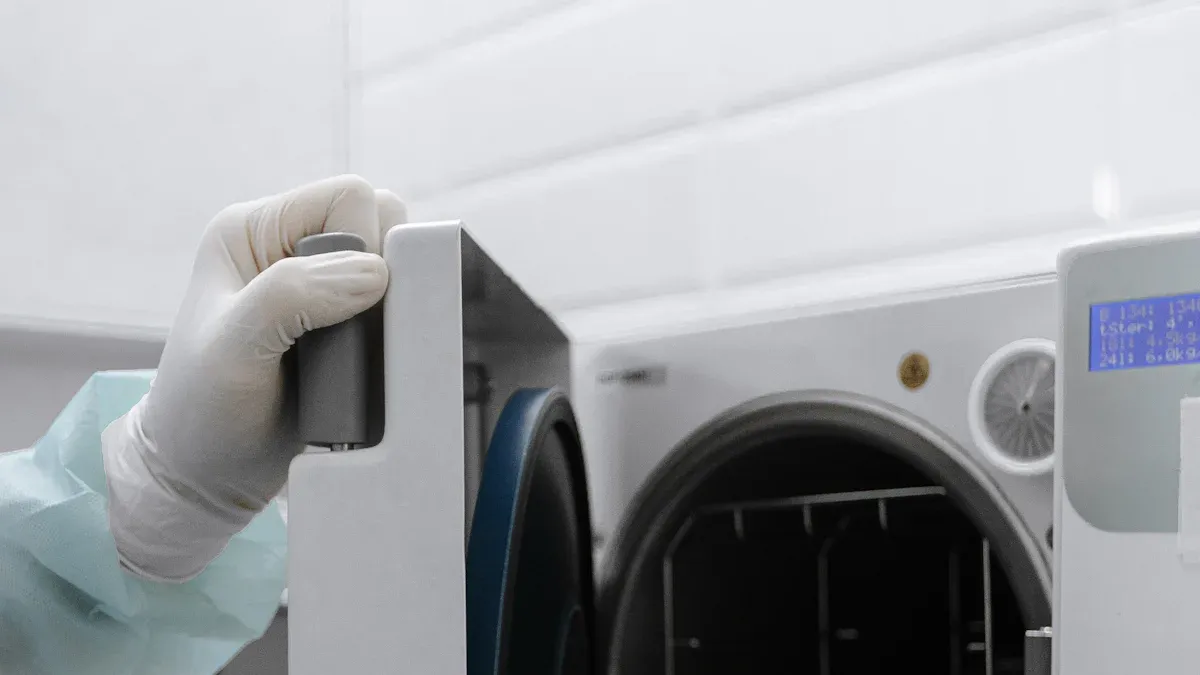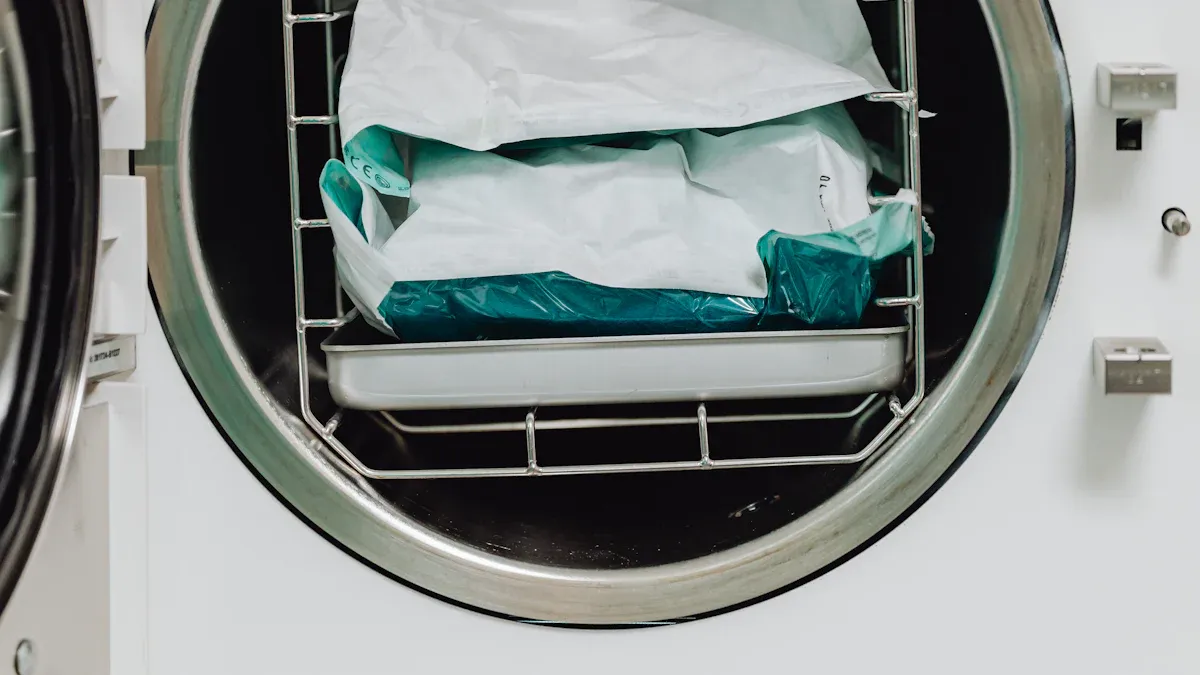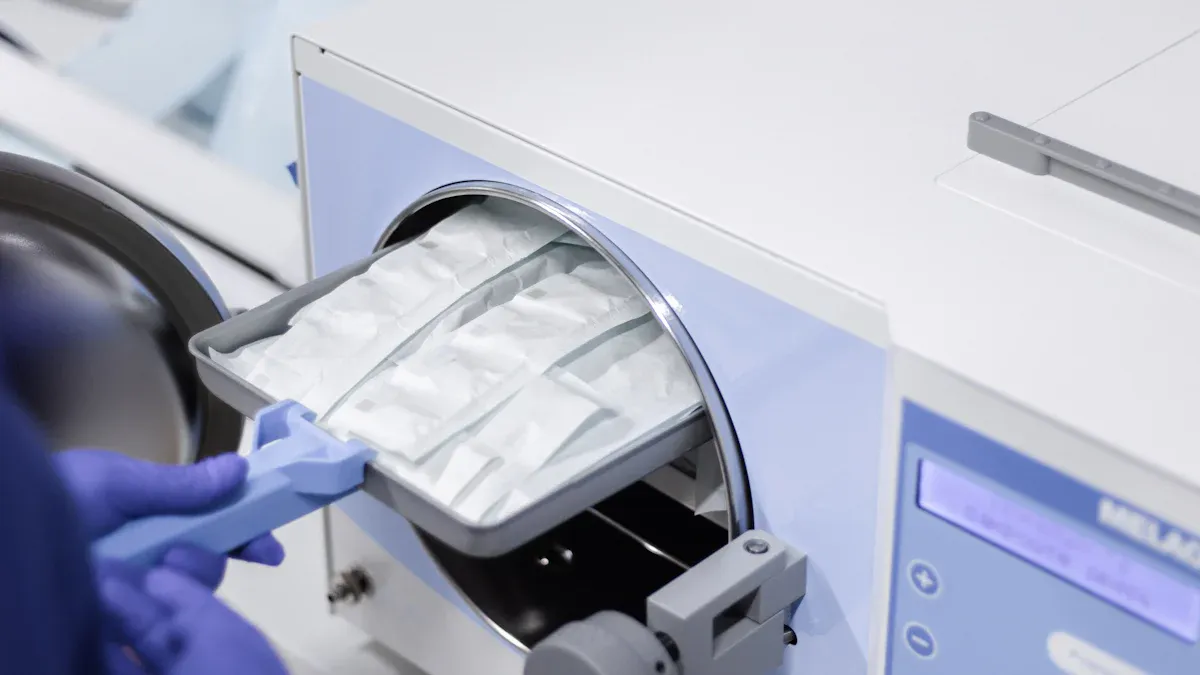How to sterilize Nitinol medical tubing safely and effectively

You need to choose sterilization methods for Nitinol medical tubing with care. Ethylene oxide and hydrogen peroxide vapor stand out as safe, effective options. High-temperature steam can damage Nitinol’s shape memory and flexibility, so avoid it unless your manufacturer recommends it. Always clean tubing thoroughly before sterilization. Surface treatments, like passivation or coatings, require special attention to avoid damage. Regulatory guidelines from the FDA and ISO help ensure your sterilization process meets strict safety and quality standards.
Key Takeaways
Use ethylene oxide or hydrogen peroxide vapor to sterilize Nitinol tubing safely, as both protect its shape and surface without harmful residues.
Avoid high-heat methods like steam autoclaving and radiation sterilization because they can damage the tubing’s shape memory and cause corrosion.
Always clean Nitinol tubing thoroughly with ultrasonic cleaning before sterilization to remove oils, debris, and oxides for effective sterilization.
Pay close attention to surface treatments like passivation and coatings to maintain corrosion resistance and biocompatibility during sterilization.
Follow FDA and ISO standards and keep detailed records of sterilization processes to ensure safety, quality, and regulatory compliance.
Sterilization Methods for Nitinol Medical Tubing

When you select sterilization methods for nitinol medical tubing, you must consider both safety and effectiveness. Not all sterilization processes work well with nitinol. Some can damage the tubing or reduce its performance. Below, you will find the most suitable sterilization methods for nitinol medical tubing, along with those you should avoid.
Ethylene Oxide (EO) Sterilization
Ethylene oxide sterilization stands out as a reliable choice for nitinol tubing. This process uses a gas that penetrates deeply into the tubing, reaching areas that other sterilization methods might miss. EO sterilization works at low temperatures, which helps protect the shape memory and flexibility of nitinol.
You can use EO sterilization for complex devices and heat-sensitive materials.
The process does not corrode or degrade nitinol surfaces.
EO sterilization achieves a high level of microbial reduction, making it suitable for medical applications.
Note: EO sterilization requires careful handling. The process takes longer than other methods, and you must manage toxic residues before using the tubing.
Technical studies show that EO sterilization is effective for nitinol wires and tubing. Researchers found that EO gas eliminates microbial contamination without damaging the material. However, the process is slow and requires strict safety controls due to the toxicity and explosiveness of EO gas.
Hydrogen Peroxide Vapor Sterilization
Hydrogen peroxide vapor sterilization offers another excellent option for nitinol medical tubing. This process uses vaporized hydrogen peroxide to sterilize devices quickly and safely. It works at low temperatures, which helps maintain the tubing’s properties.
You can complete the process in 1 to 3 hours, much faster than EO sterilization.
Hydrogen peroxide vapor leaves no toxic residue, so you can use the tubing immediately after sterilization.
The process reduces healthcare-associated infections and sterilization-related errors.
Here is a comparison of the two main sterilization methods for nitinol medical tubing:
Parameter/Outcome | Vaporized Hydrogen Peroxide (VHP) | Ethylene Oxide (EO) |
|---|---|---|
Microbial Reduction Efficacy | 6-log reduction (99.9999% kill) | Comparable 6-log reduction |
Cycle Time | 1-3 hours (up to 80% faster) | 12-24 hours |
Sterilization-Related Errors | 30% reduction reported | Baseline |
Device Reprocessing Time | 40% decrease | Baseline |
Healthcare-Associated Infections | Up to 35% reduction reported | Baseline |
Residue | None | Toxic residues present |
Material Compatibility | High, especially for heat-sensitive devices | High compatibility |
Device Usability Post-Sterilization | Immediate use possible | Requires quarantine period |
Both sterilization methods for nitinol medical tubing provide high microbial reduction and strong material compatibility. Hydrogen peroxide vapor sterilization offers faster turnaround and fewer residues, making it ideal for many clinical settings.
Methods to Avoid
You should avoid heat-based sterilization and radiation sterilization for nitinol tubing. These methods can harm the tubing’s structure and reduce its lifespan.
Heat-based sterilization, such as steam autoclaving, exposes nitinol to high temperatures. This can change the tubing’s shape memory and flexibility. Fatigue life studies show that thermal cycles and mechanical strains during sterilization can cause early material failure if not controlled.
Radiation sterilization, including gamma and electron beam methods, can alter the surface properties of nitinol. This may increase the risk of corrosion or nickel leaching, which can compromise patient safety.
Tip: Always check the manufacturer’s recommendations before choosing a sterilization process for nitinol medical tubing.
Surface treatments play a key role in selecting sterilization methods for nitinol medical tubing. Treatments like passivation, electropolishing, or coatings improve surface roughness and biocompatibility. Smoother surfaces, with a roughness (Ra) between 0.21 and 0.80 µm, reduce the risk of corrosion and nickel release. You must ensure that your chosen sterilization process does not damage these surface treatments.
Quality control measures, such as Statistical Process Control (SPC) and compliance with ISO 13485 or FDA standards, help maintain the safety and effectiveness of sterilization methods for nitinol medical tubing. These controls ensure that each process meets strict medical device requirements.
Cleaning and Contamination Control
Ultrasonic Cleaning
You must start every sterilization process with thorough cleaning. Ultrasonic cleaning stands out as one of the most effective cleaning processes for Nitinol medical tubing. This method uses sound waves to create tiny bubbles in a cleaning solution. These bubbles remove debris, oils, and oxides from the tubing surface. Research shows that lower ultrasonic frequencies, such as 28 kHz, increase cavitation activity and improve cleaning results. By adjusting the frequency and dissolved gas levels, you can boost the removal of particles and contaminants.
A clean surface is essential for successful sterilization. If you skip proper cleaning, contamination can remain on the tubing and lead to serious complications. For example, leftover debris can cause infections or even toxic reactions in patients. Authoritative bodies recommend dedicated ultrasonic cleaning protocols and equipment for sensitive instruments like Nitinol tubing. You should also use cleaning chemistries that work well with ultrasonic cavitation. Regular maintenance and quality control tests, such as ultrasonic indicators and residual protein tests, help you verify cleaning efficacy.
Tip: Always check that your cleaning processes remove all visible and invisible debris before moving to sterilization.
Preventing Contamination
You need to maintain a bright, smooth, and oil-free surface on Nitinol tubing to prevent contamination. Surface cleanliness is not just about appearance. You should verify it through microbiological cleanliness testing, chemical analysis, and bioburden tests. Advanced surface treatments, such as passivation and electropolishing, reduce corrosion and nickel ion release. These treatments help you minimize contamination and allergic reactions.
Coatings like ceramics or PTFE add another layer of protection. They enhance corrosion resistance and lower toxicological risks. You must follow strict process controls and work with certified suppliers to avoid contamination during and after sterilization. Skipping surface finishing steps or ignoring regulatory standards can increase contamination risks. Testing protocols, including wear and debris analysis and cytotoxicity assays, confirm that your tubing remains safe and clean after sterilization.
Note: Compliance with standards like ISO 13485 and ASTM F2516 ensures that your cleaning processes and sterilization steps meet the highest safety requirements.
Sterilization Compatibility and Tubing Integrity

Effects on Surface Treatments
You need to pay close attention to how sterilization methods interact with Nitinol surface treatments. The right process helps you maintain both sterilization compatibility and tubing performance. Surface treatments like passivation and electropolishing improve corrosion resistance and biocompatibility. Each step in the process changes the surface in a unique way.
Treatment Step | Surface Effect | Corrosion Resistance Impact | Analytical Methods Used |
|---|---|---|---|
Electropolishing | Formation of TiO2 passive layer; removal of mechanically deformed surface layer | Increased corrosion resistance due to improved passive layer | AFM, SEM, electrochemical tests |
Sterilization (dry heat, steam autoclaving, ethylene oxide) | Thickening and compositional changes of oxide layer | Further increase in corrosion resistance; altered oxide composition | Surface analysis, corrosion tests |
Thermal Passivation | Increased oxide layer thickness | Enhanced corrosion resistance | Electrochemical corrosion tests |
Passivation with nitric acid increases the amount of titanium dioxide on the surface and lowers nickel content. This change reduces nickel release and improves safety. Sterilization methods like ethylene oxide or hydrogen peroxide vapor thicken the oxide layer and change its composition. You must choose a sterilization process that keeps these benefits. Always check that your sterilization compatibility matches the surface treatment sequence for the best results.
Braid-Reinforced Medical Tubing
Braid-reinforced medical tubing presents unique challenges during sterilization. You must consider both the tubing material and the reinforcement inside. The sterilization compatibility of each component affects the overall device performance.
Plastic reinforcements in braid-reinforced medical tubing can degrade under high heat. This damage lowers mechanical strength.
Metal reinforcements, such as Nitinol or stainless steel, handle heat better and keep their properties after sterilization.
Silicone tubing resists heat, but the reinforcement’s thermal limit is key to maintaining performance.
The reinforcement sits inside the silicone wall, not chemically bonded. This design helps with biocompatibility and mechanical integrity.
Tubing length, diameter, and how you seal the reinforcement ends all play a role in safety after sterilization.
You should always select a sterilization method that supports the sterilization compatibility of both the tubing and the reinforcement. This approach ensures that braid-reinforced medical tubing remains safe, strong, and reliable for patient use.
Compliance and Validation
Regulatory Standards
You must follow strict regulatory standards during every cleaning, surface treatment, and sterilization step for Nitinol medical tubing. These standards help you ensure patient safety and device reliability. Several organizations set the rules for how you manage each process:
Nitinol medical tubing in CE-marked devices meets ISO 9001:2015 and ISO 13485:2016 quality management standards.
CE marking shows that your tubing complies with European medical device regulations.
The FDA provides guidance on reprocessing and sterilization validation for medical devices.
AAMI TIR12:2020/(R)2023 gives you advice on designing, testing, and labeling reusable devices for safe reprocessing.
ISO 17665:2024 covers requirements for moist heat sterilization processes.
ISO 17664-1:2021 lists the information you must provide for processing critical and semi-critical medical devices.
Tip: Always check the latest standards before you start a new sterilization process. This helps you avoid costly mistakes and ensures your tubing meets all legal requirements.
Documentation and Validation
You need to keep detailed records for every sterilization process. Proper documentation proves that your tubing meets safety and quality standards. The FDA recommends that you document the material composition, surface finish, and mechanical properties of your Nitinol devices. This information helps you track how each sterilization process affects device performance.
Validation studies show that Nitinol tubing keeps its shape memory and strength after common sterilization methods. The protective titanium oxide layer on Nitinol resists corrosion, even after repeated sterilization cycles. Accelerated aging tests confirm that the tubing remains stable and safe over time. You should record all test results, including stress and strain data, to support your process validation.
A good documentation system includes:
Written protocols for each sterilization process
Test results for mechanical and chemical stability
Records of surface treatment steps
Validation reports for each batch
Documentation Item | Purpose |
|---|---|
Sterilization protocol | Shows how you run each process |
Test results | Prove tubing meets safety standards |
Surface treatment records | Track changes to tubing surfaces |
Validation reports | Confirm long-term device reliability |
Keeping clear records helps you pass audits and protects your patients. You can show that every sterilization process keeps your Nitinol tubing safe, effective, and ready for use.
You should always choose sterilization methods that protect Nitinol tubing’s shape and strength. Start with thorough cleaning before each sterilization step. Pay attention to surface treatments to keep tubing safe and effective. Follow sterilization protocols that meet ISO and FDA standards. Studies show tubing keeps over 88% of its strength and resists discoloration after repeated sterilization. You can trust that proper sterilization maintains tubing integrity. Always check manufacturer guidelines and review new sterilization standards for the best results. For more details, explore resources on medical device sterilization protocols.
FAQ
What is the safest way to sterilize Nitinol medical tubing?
You should use ethylene oxide or hydrogen peroxide vapor. Both methods protect the tubing’s shape and surface. They work at low temperatures and do not leave harmful residues.
Can I use steam autoclaving for Nitinol tubing?
You should avoid steam autoclaving. High heat can change the tubing’s shape memory and flexibility. This damage may reduce device performance and safety.
How do I ensure Nitinol tubing stays clean before sterilization?
You should use ultrasonic cleaning. This process removes oils, debris, and oxides from the surface. Always check for visible and invisible contamination before moving to sterilization.
Are these sterilization methods suitable for devices used in minimally invasive surgical procedures?
Yes, you can use ethylene oxide and hydrogen peroxide vapor for devices in minimally invasive surgical procedures. These methods keep the tubing safe and effective for sensitive applications.
What documentation do I need for sterilizing Nitinol tubing?
You need written protocols, test results, and validation reports. These records show that your process meets safety and quality standards. Good documentation helps you pass audits and protect patients.
See Also
The Process Behind Manufacturing Nitinol Tubing For Medicine
The Importance Of Nitinol Tubing In Modern Medical Use
How Nitinol Tubing Drives Progress In Medical Technology
Ways Nitinol Tubing Is Transforming Medical Device Innovation

